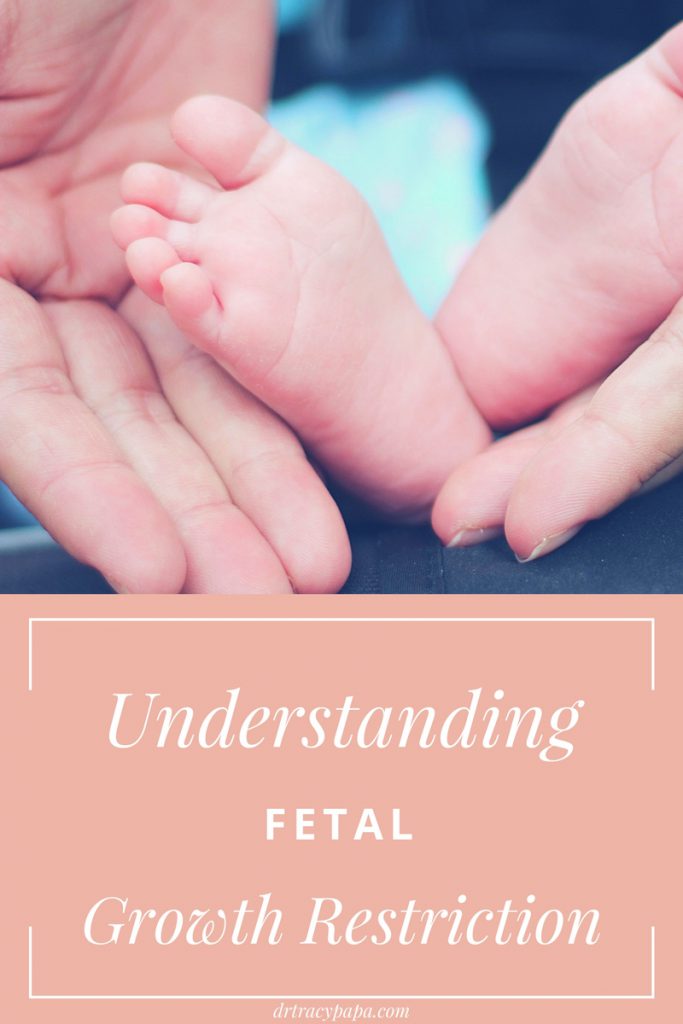Understanding Fetal Growth Restriction | What Happens When My Baby's Growth Is Restricted?
Babies come in all shapes and sizes. At 32 weeks, for instance, it would be normal for your baby to weigh anywhere between 3 1/2 pounds and 6 1/2 pounds. That's quite a range! So how small is too small? When should you be concerned? Why are some babies bigger or smaller than others? And what do we do about it?
Having your baby measured
When you see your OB provider for routine visits, your tummy will be measured, from the pubic bone to the top of the uterus.
Typically, after 20 weeks, your uterus will measure in centimeters about how far along you are in weeks (so at 24 weeks, the measurement should be about 24 cm). If there is more than a 3-4 centimeter variance, we become suspicious that the baby’s growth is lagging behind or jumping ahead. We will talk about big babies in another post.
Today, let’s talk about what happens when your OB provider suspects that your fetus is small.
Reasons baby's growth may be restricted
The next step is usually an ultrasound.
We estimate the fetal weight by measuring the head, abdomen, and thigh bone (femur). The estimated weight is then plotted on a graph. If the overall size is in the bottom ten percent of fetuses at that gestational age, we say that the baby is growth restricted. This can happen for a variety of reasons.
1.) Constitutional
In other words, normal small. Not everyone is meant to have a 7.5-pound baby at term. If you are petite yourself, or Asian ethnicity, or have a family history of small babies, it is not surprising if your baby is also small.
2.) Birth defects
Some fetal anomalies can affect a baby’s growth, so when a fetus measures small, we look very carefully for evidence of anomalies. Not all fetal anomalies are detectable with ultrasound, but we try.
3.) Genetic or chromosomal abnormalities
We have talked before about chromosome abnormalities like Trisomy 18. We know that living creatures are meant to have just the right amount of genetic material, not one drop more or less. There is testing that can be done to look for genetic and chromosome abnormalities – these tests include amniocentesis and blood work.

4.) Infections
Some viruses and other types of infections can affect fetal growth.
Cytomegalovirus (CMV), toxoplasma, rubella, parvovirus, herpes viruses, and probably hundreds of others. These may not cause a serious infection in pregnant moms. But fetuses may be more susceptible to damage from the virus. There are blood tests that can be performed to look for antibodies to some of the most common viruses that affect fetal growth.
If you have amniocentesis, we can look for viral DNA in the amniotic fluid.
5.) Placental problems
The placenta is a vitally important and under-appreciated organ.
It is the structure that connects your circulation with your baby’s. For various reasons (diabetes, autoimmune disease, high blood pressure, blood clotting abnormalities, and many others), the placenta sometimes doesn’t do its job properly.
When this happens, the baby doesn’t receive as much blood flow, oxygen, and nutrients, and growth slows down.
What happens when there is fetal growth restriction?
When we confirm that your baby is, in fact, growth restricted, now what?
Well, we watch your baby more closely until delivery. In our office, we usually see patients with smaller babies twice weekly for fetal testing in the third trimester. For more about how we perform the testing, see my post titled The Fifth M of Gestational Diabetes – Monitor.
We may also try to modify any risk factors that we have some control over. For instance, if you are a smoker, we ask you to quit. If you have hypertension, we try to optimize your blood pressure. If you exercise compulsively, ease up.
Delivery and birth of growth restricted babies
When do we recommend that growth restricted fetuses be delivered?
In general, if all testing is reassuring, delivery is recommended within the last 2 weeks of pregnancy; in other words, 38-40 weeks.
But if there are changes in the fetal heart rate tracing, or abnormal umbilical artery blood flow on ultrasound, or low amniotic fluid volume, or other complications (like hypertension), delivery may need to happen sooner. Outcomes for these babies vary, depending on gestational age and weight at the time of delivery, and the presence or absence of birth defects or infections.
Fortunately, most of these babies do well long term. If you have a baby who is measuring smaller, talk with your OB provider. Ask all the questions you need to, to make sure you have a good understanding of what is happening. Let your OB know if the baby seems to be moving less, or if you have any more concerns.
In conclusion
There are a variety of reasons why your baby may be growth restricted. Babies naturally vary in size and in most cases there is nothing to be worried about. Making lifestyle changes, understanding your family's history, or having certain genetic tests will help you better understand your risks if any. Keep checking in with your doctor and ask questions.

